HML 2021 Virtual Health Make-a-Thon Gives Citizen Scientists a Shot at Making Their Health-Related Innovations a Reality
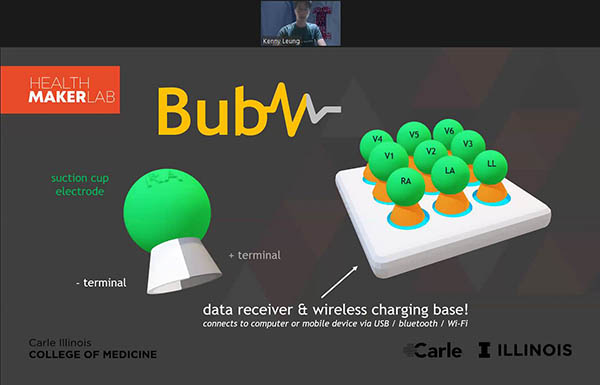
During the 2021 Virtual Health Make-a-Thon Competition, Kenny Leung presents a slide explaining how his idea, "A Wire-Free, 12-Lead EKG" works.
April 19, 2021
Eyes on the prize, twenty teams of “citizen scientists” from across the state—students, healthcare workers, educators, entrepreneurs, community members, and professionals—participated in the Spring 2021 Virtual Health Make-a-Thon competition on Saturday, August 17th. The prize? A Maker Lab Innovation coin that would entitle the bearer to $10,000-worth of resources from the University of Illinois’s Health Maker Lab (HML) network. The citizen scientists' goal? To come up with a health innovation that would make a difference.
Led by the HML and the Carle Illinois College of Medicine (CI MED), the 2021 Virtual Health Make-a-Thon competition had as its overarching goal to promote the democratization of health innovation by creating a culture of innovation. Held via Zoom, the competition gave 20 finalists the opportunity to give a two-minute pitch presenting their idea.
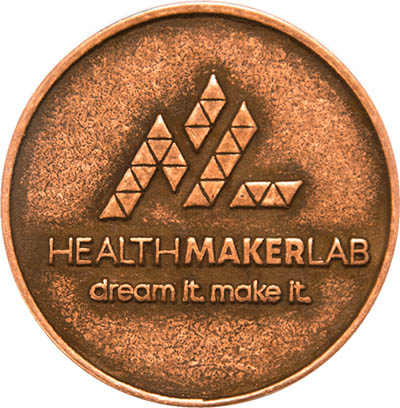
HML coin worth $10,000-worth of resources from the Health Maker Lab.
The 20 finalists had been winnowed down from the original 95 applicants. By the end of the Make-a-Thon, the 20 had been down narrowed down to 10 winners, who will have access to the Illinois’ network of 20 design and making facilities—the Health Maker Lab nodes—where winners will be able to develop prototypes of their ideas.
Regarding the prize winners received—resources from the Health Maker Lab—exactly what is the HML? According to its website, it’s a network of maker labs and design spaces, or nodes, which “agree on one goal: to improve the world’s health,” and “where your health invention can emerge.” During his introduction of the HML, Marty Burke gave it a catchy yet apropos nickname, calling it a "Billion-Dollar Garage." Comprised of 20 maker labs scattered across the Illinois campus, HML has as its motto: “If you can dream it, we will help you make it.” Reflecting the multi-disciplinary nature of the HML, several representative nodes include the Roy J. Carver Biotechnology Center, the Molecule Maker Lab, the Holonyak Micro and Nanotechnology Lab, the Grainger Idea Lab, and Siebel Center for Design.
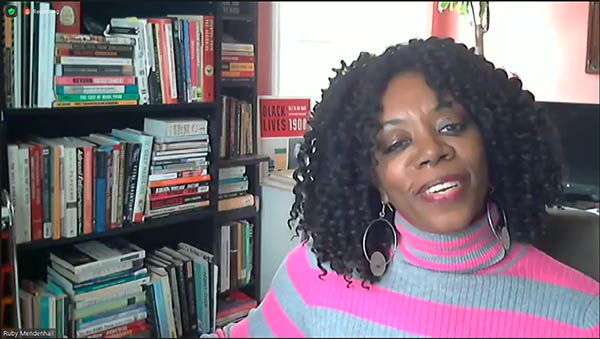
Ruby Mendenhall welcomes participants, Dolphin Tank, and visitors to the Make-a-Thon.
Making introductory remarks and sharing relevant information, including the role of the citizen scientist in the democratization of health innovation were members of the HML Executive Team. They also shared various Make-a-Thon components, such as how Dolphin Tank and audience members (which Mendenhall dubbed, "the Dolphin Ocean") were to vote via the app, and served as MCs for the event. The Executive Team includes Marty Burke, Chemistry Professor and CI MED Associate Dean for Research; Ruby Mendenhall, Sociology Professor and Assistant Dean for Diversity and Democratization of Health Innovation at CI MED; Irfan Ahmad, Health Maker Lab Executive Director and CI MED Assistant Dean for Research, and Lisa Goodpaster, Associate Director for Project Management at CI MED. The team also introduced the Health Maker Lab Nodes and thanked the many mentors assigned to help the 20 finalists. Ahmad and Goodpaster helped with clock management and kept the event running in a timely fashion.
Integral to the Make-a-Thon was a panel of 20 judges called the Dolphin Tank. This kinder, gentler version of the Shark Tank of tv fame was comprised of educators, industry representatives/entrepreneurs, healthcare providers, scientists, engineers, and community experts—all authorities in their fields who applied their knowledge and skills to choosing ideas that were innovative, needed, and doable with the help of the HML.

Khan Siddiqui asks a presenter a question about their design during a Q&A session.
Members of the Dolphin Tank included University faculty, such as Electrical and Computer Engineering Professor Stephen Boppart and Rachel Switzky, Director, Siebel Center for Design; CI MED personnel, such as King Li, CI MED Dean; Medical Practitioners, such as Blair M. Rowitz, a Carle MD; Lynn Hassan Jones, diagnostic radiologist physician and Board Member of Avicenna Community Health Center; Issam Moussa, a Carle interventional cardiologist; and Khan Siddiqui, MD, a radiologist, engineer, and serial entrepreneur interested in bringing healthcare to the masses through AI; Chirag Patel, MD; Mukund Chorghade, Founder, President & Chief Scientific Officer, THINQ Pharma; Lakita Scott, VP of Quality, Carle Health Diversity Advocate; John Thode, Clinical Professor for Innovation, Leadership & Engineering Entrepreneurship at Illinois’ Technology Entrepreneur Center; Pamela Jolly, Founder and CEO of Torch Engerprises; Paul Epner, CEO and Co-founder of the Society to Improve Diagnosis in Medicine; Ernest Recarlos Harvey, local businessman interested in fostering health wellness in the community; Laura Arriola Miller, Communications Coordinator, Health Alliance Medical Plans; John Flygare, medicine pioneer; Bertha Purnell, Founder and CEO of Mothers On a Mission; Barbara Gillespie, NAACP Afro Academic, Cultural, Technological, and Scientific Olympics (ACT-SO); Karen Simms, Founder of Trauma Resiliancy Intitiative; plus, the youngest member of the Dolphin Tank, Carrington Thornton, who won an award for asking the most questions during the Q&A periods.
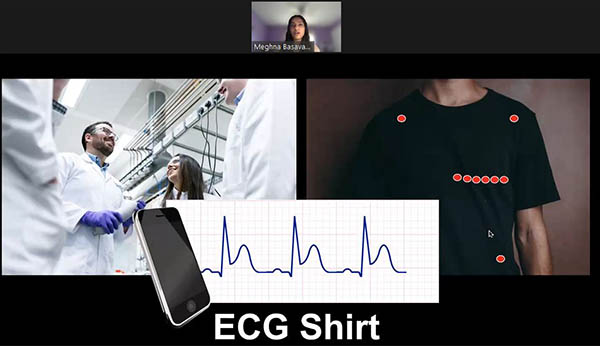
Meghna Basavaraju discusses her team's innovation: the "ECG Shirt."
Of course, the crux of the competition was a 2-minute pitch by each team who presented their innovative, health-related ideas, the subsequent 2-minute Q&A period where Dolphin Tank members (and members of the audience) could ask the finalist(s) questions, and lastly, a 1-minute voting period.
Ideas pitched by the 20 finalists included a diverse selection of health-related ideas ranging from artificial intelligence, to apps, to devices, to training. Once all the finalists had presented their pitches, votes by judges (and audience members) were tabulated to select the 10 winners. While winners were being decided, the special speaker, Dr. Yemaya Bordain, shared about her journey regarding appreciating sleep and encouraged everyone to make sleep a foundation. Her closing exhortation to Make-a-Thon watchers: "Go to Sleep!" Bordain's talk was followed by a greeting from Chancellor Robert Jones.
Finally, the 10 winners were announced. The winning ideas for the 2021 Virtual Health Make-A-Thon were:
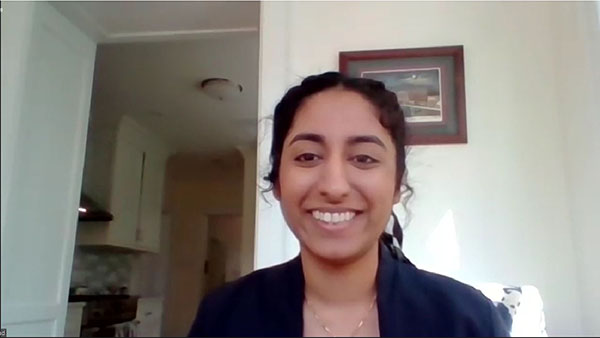 During the competition, Tayyaba Ali presents her team's device: "CalidGear: Wearable Thermoregulation Device."
During the competition, Tayyaba Ali presents her team's device: "CalidGear: Wearable Thermoregulation Device."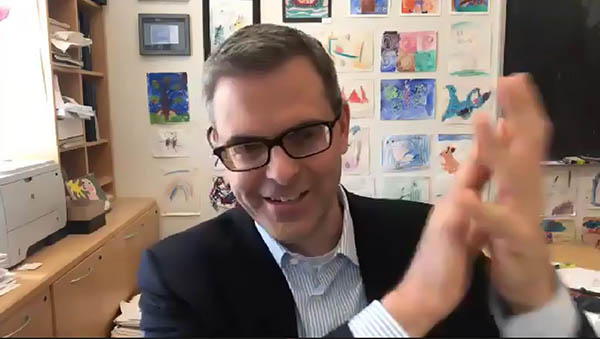
After announcing the ten winning teams, Marty Burke gives them a hand.
- A Wire-Free, 12-Lead EKG, by Kenny Leung
- CalidGear: Wearable Thermoregulation Device, by Tayyaba Ali, Luke Navas, and Aashna Mehta.
- ECG Shirt, by Hanna Erickson, Manisha Reddy, and Meghna Basavaraju
- Healing Healthcare Disparities among BIPOC Patients through Virtual Reality Cultural Competency Training, by Victoria Fields, Mardia Bishop, Charee Thompson, and Sarah Bencivenga
- izzii - An App That Aids in Generalizability and Inclusion in Phase III Clinical Trials, by Sneha Subramanian, and Avani Patel
- Music to My Ears, A Balm from Bronzevile, by Malik Ali Muhammad and Ray Muhammad
- Nano-Hyperbaric Delivery System for Chronic Wound Care, by Michael Tsipursky and Joseph Irudayaraj
- Preventing Acute Renal Failure after Crush Injury, by Nathaniel Brooke and Ariana Barreau
- ProteCKD: Earlier Detection of Chronic Kidney Disease among Underrepresented Patient Populations, by Ariana Barreau, Phani Gaddipati, Andrew Chang, Isabella Lebovic, Priya Kumar, and Thomas Chow
- STEM Vocabulary App for Deaf Students, by Mona Jawad, Ethan Gaughan, Aditi Adya , Ryan Martin, Ayesha Kazi, Sumayyah Hussain, Amy Lee, Elizabeth Troy, and Sri Medisetti
Winners of the 2021 Virtual Health Make-a-Thon competition report that winning will have a significant impact on helping their health-related innovations to become a reality. For example, Victoria Fields from the "Healing Healthcare Disparities among BIPOC Patients through Virtual Reality Cultural Competency Training," team spoke for her team about being one of the winners:
 Victoria Fields from the winning "Healing Healthcare Disparities among BIPOC Patients through Virtual Reality Cultural Competency Training," team. (Image courtesy of Victoria Fiellds.)
Victoria Fields from the winning "Healing Healthcare Disparities among BIPOC Patients through Virtual Reality Cultural Competency Training," team. (Image courtesy of Victoria Fiellds.)"Winning means having the resources to address racism in medicine and the opportunity to make a widespread and positive public health impact by decreasing health disparities."
Mona Jawad, a member of another winning team, "STEM Vocabulary App for Deaf Students," shares what winning means to her team: "For us, winning the Make-A-Thon is a win for accessible education. Our team is more driven than ever to help open the doors of science to everyone."
Another winner was Kenny Leung, a medical student at CI MED who created Bubz, a novel 12-lead EKG system that uses no wires. (The wireless electrodes stick onto the patient!). Leung shares how he came up with the idea.
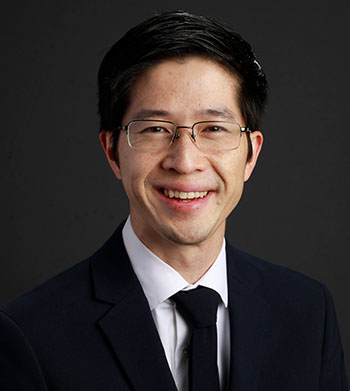
Kenny Leung, designer of Bubz, a novel 12-lead EKG system that uses no wires. (Image courtesy of Kenny Leung.)
During pediatric cardiology week, a practitioner shared that kids sometimes pull on the EKG wires, thus, it’s hard to keep them on. Plus, during a cardiology rehabilitation experience, Leung discovered that the wires introduce noise to the EKG reading.
“When I used to work in cardiology IT,” he explains, “my manager shared that if I was able to design an EKG without wires, that would be very impactful. Lastly, during trauma service, I noticed that all patients who came in to the trauma bay had EKG leads, but they can be in the way when we are trying to cut all the clothes off for a full body assessment. Hearing and noticing these problems enticed me to dig more and come up with a technologically feasible solution.”
Leung conveys what winning means: “The Carle Illinois Health Make-a-Thon has a plethora of mentors and labs that can help us succeed in bringing our ideas into reality," Leung says. "I’m excited to work with these amazing mentors and hopefully introduce a useful device into the healthcare space!”
Story by Elizabeth Innes, Communications Specialist, I-STEM Education Initiative. Photos by Elizabeth Innes unless otherwise noted.
For more related stories, see: Carle Illinois, 2021
For an additional I-STEM articles about Carle Illinois College of Medicine, see:
- HML 2021 Health Make-a-Thon Orientation Prepares Finalists for Competition
- Carle Illinois Student-Centered Health Make-A-Thon Addresses Racism as a Health Crisis
- Health Make-a-Thon Encourages Local Citizens to Dream Up Ideas for Improving Health
- The (Future) Doctor is in the House: Meet an Illinoisan in the Inaugural Carle Illinois Medical Program
- Underrepresented Minority Undergraduate Students Gain Research, Clinical Experience Via the Carle Illinois College of Medicine’s New REACH RCEU
- Undergrad Brione Griffin Gets One Step Closer to Her Dream of Becoming a Doctor Via REACH RCEU

Contestant Ariana Barreau presents a slide about her team's idea, "ProteCKD: Earlier Detection of Chronic Kidney Disease among Underrepresented Patient Populations" during the 2021 Virtual Health Make-a-Thon Competition.













.jpg)















